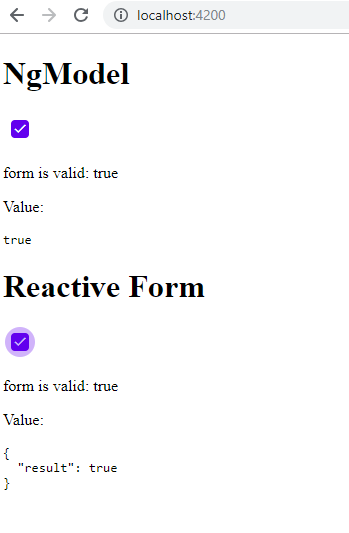Using Angular ControlValueAccessor interface
This topic will go over how to use Smart CheckBox component and use ngModel forms and Reactive Forms.
1. Creating the Component smart-input.component.ts
import { Component, Input, forwardRef } from '@angular/core';
import { ControlValueAccessor, NG_VALUE_ACCESSOR, NG_VALIDATORS, FormControl, Validator } from '@angular/forms';
@Component({
selector: 'smart-input',
template:
`
<smart-check-box
[checked]="value"
(change)="onChange($event)"
(keyup)="onChange($event)">
</smart-check-box>
`,
providers: [
{
provide: NG_VALUE_ACCESSOR,
useExisting: forwardRef(() => SmartInputComponent),
multi: true,
},
{
provide: NG_VALIDATORS,
useExisting: forwardRef(() => SmartInputComponent),
multi: true,
}]
})
export class SmartInputComponent implements ControlValueAccessor, Validator {
private value: boolean;
private data: any;
// this is the initial value set to the component
public writeValue(obj: any) {
if (obj) {
this.data = obj;
this.value = this.data;
}
}
// registers 'fn' that will be fired wheb changes are made
// this is how we emit the changes back to the form
public registerOnChange(fn: any) {
this.propagateChange = fn;
}
// validates the form, returns null when valid else the validation object
// in this case we're checking if the smart parsing has passed or failed from the onChange method
public validate(c: FormControl) {
return true;
}
// not used, used for touch input
public registerOnTouched() { }
// change events from the checkbox
private onChange(event) {
// get value from checkbox
let newValue = event.target.checked;
this.data = newValue;
// update the form
this.propagateChange(this.data);
}
// the method set in registerOnChange to emit changes back to the form
private propagateChange = (_: any) => { };
}
2. Creating smart-input.module.ts
import { FormsModule, ReactiveFormsModule } from '@angular/forms';
import { CommonModule } from '@angular/common';
import { NgModule, CUSTOM_ELEMENTS_SCHEMA } from '@angular/core';
import { SmartInputComponent } from './smart-input.component';
@NgModule({
imports: [
CommonModule,
FormsModule,
],
schemas: [ CUSTOM_ELEMENTS_SCHEMA ],
exports: [
SmartInputComponent,
],
declarations: [
SmartInputComponent,
],
providers: [],
})
export class SmartInputModule { }
3. Creating app.module.ts
import { NgModule, CUSTOM_ELEMENTS_SCHEMA } from '@angular/core';
import { BrowserModule } from '@angular/platform-browser';
import { FormsModule,ReactiveFormsModule } from '@angular/forms';
import { SmartInputModule } from './smart-input.module';
import { AppComponent } from './app.component';
import '@smarthtmlelements/smart-core/source/smart.core.js';
@NgModule({
declarations: [AppComponent],
imports: [BrowserModule, FormsModule, ReactiveFormsModule, SmartInputModule],
schemas: [ CUSTOM_ELEMENTS_SCHEMA ],
providers: [],
bootstrap: [AppComponent]
})
export class AppModule { }
4. Creating app.component.ts
import { Component, OnInit } from '@angular/core';
import { FormGroup, FormBuilder } from '@angular/forms';
export class Hero {
id: number;
name: string;
}
@Component({
selector: 'app-root',
template: `
<h1>NgModel</h1>
<form #form="ngForm">
<smart-input [(ngModel)]="result" name="result"></smart-input>
</form>
<p>form is valid: {{ form.valid ? 'true' : 'false' }}</p>
<p>Value:</p>
<pre>{{ result}}</pre>
<h1>Reactive Form</h1>
<form [formGroup]="reactiveForm">
<smart-input formControlName="result"></smart-input>
</form>
<p>form is valid: {{ reactiveForm.valid ? 'true' : 'false' }}</p>
<p>Value:</p>
<pre>{{ reactiveForm.value | json}}</pre>
`
})
export class AppComponent {
public result = {};
public reactiveForm: FormGroup;
constructor(private fb: FormBuilder) {
this.result = true;
this.reactiveForm = this.fb.group({
result: true;
})
}
}
Result:

Note: In the package.json, you should include a dependency to Smart's npm package. Ex: "@smarthtmlelements/smart-core": "2.0.0"
Download our example from here:
angular-controlvalueaccessor-sample.zip.